Introduction
The first time I tried to create a personal conlang was in 2016. It went through a few changes and was, at one point, named läin höuror. Sänirtäm is the (hopefully) final version of this personal conlang.
When I first started working on Sänirtäm, I was fairly interested in creating a language with the aesthetics of Sanskrit. I was also interested in Finnish, and toyed with the idea of having vowel harmony. This idea was scrapped when I decided that I also wanted to be able to pronounce this language.
Sänirtäm is nominative-accusative and agglutinative, because I really like agglutination. It also has a lot of "paired" verbs, where changing the final vowel from /a/ to /u/ changes the meaning from passive to active.
Consonants
Sänirtäm's consonants are fairly "normal" by European standards:
- Nasals: m n (ɲ) (ŋ)
- Stops: p b t d (c) (ɟ) k g
- Affricates: (tɕ) (dʑ)
- Fricatives: s (ɕ) (ç) (x) h
- Approximants: (ʋ) r l j w
- Syllable-final /h/ → [x]
- [ŋ] is a rare sound that only occurs before /g/ and /k/
Certain consonants are palatalized before (and sometimes after) front vowels:
- /n/ → [ɲ] (non /ˈnon/ vs. nisvah /ˈɲiɕ.wəx/)
- /t/ → [tɕ] (tovnas /ˈtou.nəs/ vs. täm /ˈtɕæm/)
- /d/ → [dʑ] (dawa /ˈdɑ.wə/ vs. däras /ˈdʑæ.rəs/)
- /k/ → [c] (kavara /ˈkɑ.wə.ˌrɑ/ vs. kera /ˈce.rə/)
- /g/ → [ɟ] (gunan /ˈgu.nən/ vs. geskerrada /ˈɟeɕ.cer.ˌrɑ.də/)
- /s/ → [ɕ] (sohres /ˈsox.reɕ/ vs. sän /ˈɕæɲ/)
- /h/ → [ç] (hanem /ˈhɑ.ɲem/ vs. hinnas /ˈçiɲ.ɲəs/)
- /w/ → [ʋ] (varjas /ˈwɑr.jəs/ vs. vihki /ˈʋiç.ci/)
The /w/ shifting to [ʋ] was a result of me wanting both sounds in the language, but not wanting them to be represented by separate letters. I don't actually know if this happens in any natlang.
Vowels
Vowels are not particularly unusual. The only allophone is [ə], which is what /ɑ/ becomes in unstressed syllables.
- Front: i e æ
- Central: (ə)
- Back: u o ɑ
/ɑ/ and /o/ followed by syllable-final /w/ become diphthongs:
- /ɑw/ → /ɑu/
- /ow/ → /ou/
Diphthongs do not exist otherwise.
Syllable Structure & Stress
Syllable structure is (C)V(F):
- C = any consonant
- V = any vowel
- F = nasals, fricatives, & /w/ (never word-finally)
Primary stress falls on the initial syllable, and secondary stress falls on every other syllable.
Orthography
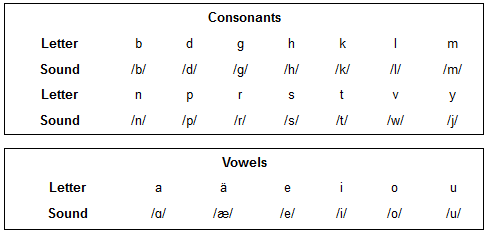
With the exception of <ä>, zero letters use diacritics. This was a deliberate decision, as the US-International keyboard doesn't allow you to type every diacritic on every letter. I did not want to continually have to copy/paste letters.
/w/ is represented by specifically because I wanted Sänirtäm to look more like Sanskrit. I don't particularly think I succeeded in that endeavor.
Demonstrative Articles
Sänirtäm has four demonstrative articles: proximal, distal, medial, and one that means "on/at":
- tokairo - "here, on/at me"
- kairo - "this, close to me"
- muru - "that, close to you"
- vere - "that, far from us both"
Pronouns
Sänirtäm doesn't have any pronouns, because I wanted to see if I could make a language without them.
In place of first-person pronouns (I, me, we, us), Sänirtäm uses the demonstrative tokairo "this, at/on me" + tären "person". Names are used instead of second-person pronouns.
Proximal/media/distal demonstratives are used in place of third-person pronouns:
- kairo tären - "this person" - the person close to me
- muru tären - "that person" - the person close to you
- vere tären - "yonder person" - the person far away from the both of us
Nouns & Adjectives
Nouns are either animate or inanimate, and inflected for case, number, and gender.
- Cases: nominative, accusative, genitive, dative, ablative, allative
- Number: singular, dual, plural
- Gender: animate, inanimate
Animate nouns end in consonants in the nominative singular and are declined as such:
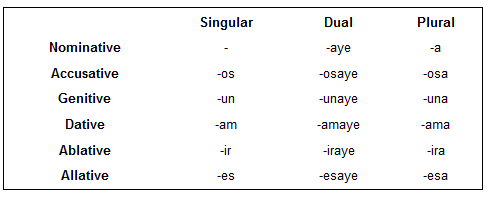
Inanimate nouns end in vowels in the nominative singular and follow this declension:
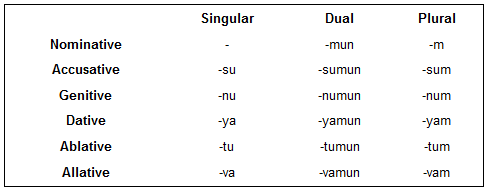
Adjectives come in front of nouns and agree in case, number, and gender:
- Animate: han hinnas "red star"
- Inanimate: hana kerra "red paper" - since kerra is an inanimate noun, han gains a final "a" to match the noun's gender
Verbs
Verbs are conjugated for tense and mood, and are grouped into two categories: active and passive.
- Tenses: present, recent past, far past, near future, far future
- Moods: indicative, subjunctive, conditional, optative, imperative
Passive verbs are primarily verbs that the agent has little or no control over:
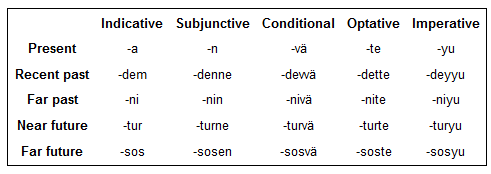
Examples of passive verbs:
- dänna - to be moved, to be acted upon by a force
- illa - to exist
- kässora - to unknowingly tell a lie
Active verbs are verbs that the agent has full control over:
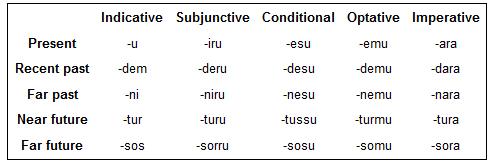
Examples of active verbs:
- dänni - to move (physically), to act
- illu - to live
- kässoru - to deliberately tell a lie
Example Sentences
Baruh tevna maunos.
- The dog sees the cat.
- dog.NOM.SG see.PRS.IND cat.ACC.SG
Sur maun tevnudem kelos baruhos.
- The black cat recently looked at the yellow dog.
- black.NOM.SG cat.NOM.SG look.RPST.IND dog.ACC.SG
Tokairo tären litaradem es Sänirtamos savniyunesu.
- I was recently inspired, so I'm currently working on Sänirtam.
- here person.NOM.SG inspire.RPST.IND thus Sanirtäm.ACC.SG build.PRS.COND